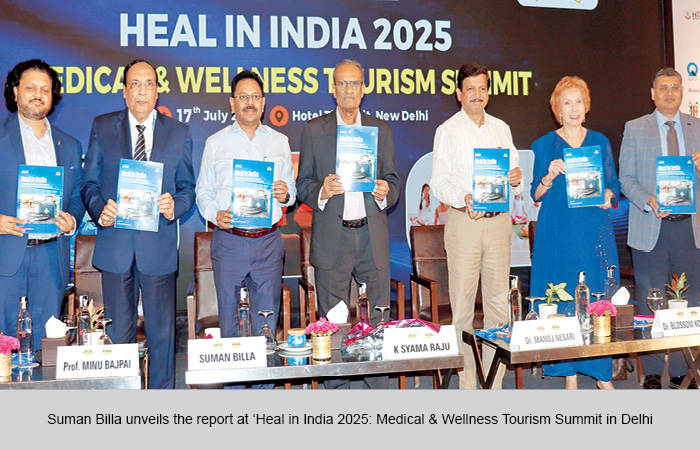Suman Billa, Director General, Ministry of Tourism, has highlighted that ‘Heal in India’ campaign aims to transform the country into a global healing destination, leveraging Ayurveda, modern healthcare and seamless ecosystems to drive tourism-led GDP growth.
Surbhi Sharma
In a world increasingly seeking holistic healing, India stands at a crossroads — one where wellness meets economic ambition. Speaking at ‘Heal in India 2025: Medical & Wellness Tourism Summit’, Suman Billa, Additional Secretary and Director General, Ministry of Tourism, Government of India, articulated a powerful vision — India’s tourism economy must reach $3 trillion by 2047 — to mark 100 years of independence. At the heart of this goal lies a clear strategy — making medical and wellness tourism not just sectors, but strategic pillars of India’s global positioning.
The Federation of Hotel and Restaurant Associations of India (FHRAI) organised the summit recently in Delhi with a view to elevating India’s position on the global healthcare map.
Medical & wellness: India’s strategic edge
Billa said India is uniquely poised at the intersection of clinical excellence and cultural wisdom. While other countries may boast advanced medical facilities or ancient healing systems, India blends both. “Our USP is not just great doctors and hospitals, but our ancient systems of healing — Ayurveda, Yoga, Siddha that treat the body, mind and spirit.” The key message from him was that India must evolve from being a place “where you are treated to where you come
to heal.”
Medical tourism, currently valued at $7.6 billion, and wellness tourism at $19.4 billion, are expected to double in five years, making them critical for tourism-led GDP growth, job creation and foreign exchange.
The DG Tourism emphasised the importance of trust to generate business. “The challenge isn’t just scale — it’s trust. Therefore, India’s credibility in this sector must rest on seamless experiences, exceptional services, international standards, safety and security.”
Digital, clusters & incentives
To make Heal in India a global movement, Billa stressed the need to create a unified digital platform integrating hospitals, tour operators, hotels and wellness centres. “Identify 10 medical-wellness tourism clusters by 2027 to act as focused growth zones. Incentivise states and service providers for quality outcomes, campaigns and forex contributions. Run global campaigns targeting GCC, Africa and SAARC for medical tourism, and the West for wellness tourism to position India as the world’s preferred healing destination. Bridge gaps in standardisation and skilling, especially in tier II and III cities.” In his concluding note, Billa said, “To project India as a healing soft power, we need to make ‘Heal in India’ campaign a global movement where the country heals the world, not just with its science but also with its soul.”
The day-long summit brought together thought leaders and policy-makers across healthcare, wellness, tourism and hospitality sectors. K Syama Raju, President, FHRAI; Someswara Koundinya, Director, KPMG India; Rahool Macarius, Market Managing Director – Eurasia, Wyndham Hotels & Resorts; Yogendra Agnihotri, Senior Regional Director Operations – South Asia, RHG; Subhas Goyal, Chairman, STIC Travels, and Sunil Khetarpal, Director, Association of Healthcare Providers (India) were among the dignitaries attending the summit.
 TravTalk India Online Magazine
TravTalk India Online Magazine





